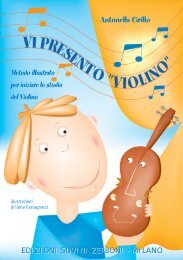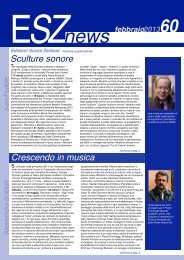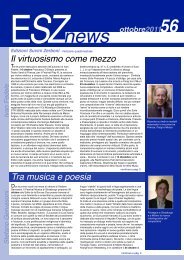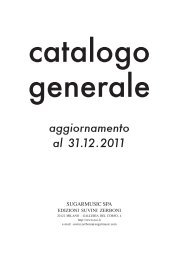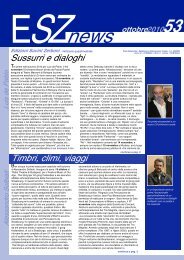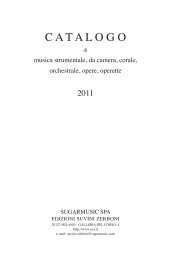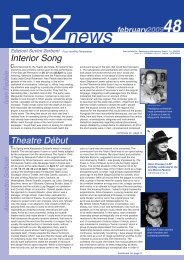Timbral Spaces Sound Labyrinths - Edizioni Suvini Zerboni
Timbral Spaces Sound Labyrinths - Edizioni Suvini Zerboni
Timbral Spaces Sound Labyrinths - Edizioni Suvini Zerboni
You also want an ePaper? Increase the reach of your titles
YUMPU automatically turns print PDFs into web optimized ePapers that Google loves.
Giorgio Gaslini<br />
Leaps and Dances<br />
O<br />
n September 9, in the Basilica of Bagno di Romagna,<br />
during the series “Natura in Concerto”, Roberto<br />
Fabbriciani, with the Orchestra Filarmonica di Roma<br />
conducted by Ezio Monti, played the Concerto for flute,<br />
strings, harp and percussion. The concerto is dedicated<br />
to Roberto Fabbriciani and will be added to a Cd, now<br />
being prepared by the label Tactus, featuring Giorgio<br />
Gaslini’s complete works for flute. The composer<br />
describes his new work: «The work is in three<br />
movements: the first starts in a mood marked “Solenne”<br />
and then suddenly frees itself and leaps into a<br />
“Moderato” that plays on the dialogue and contrast<br />
between the flute and the orchestra, not without<br />
moments of lyricism. The first movement ends with an<br />
arioso-like “Largo” which alludes to the opening<br />
“Solenne”. The second movement is a “Larghetto” in<br />
which an arioso, intimate mood prevails, finally evolving<br />
into an ethereal sonic space. The third movement is a<br />
“Vivace”. The orchestra is highly active and offers<br />
surprising harmonic and polyphonic solutions which<br />
involve the flute in fast virtuoso passages of<br />
convergence/divergence, conceding it an aria and then<br />
a solo cadenza. All comes back together in an “Allegro<br />
giocoso” that unexpectedly leaps into a neo-baroque<br />
Henri Pousseur<br />
Esprit de Géométrie<br />
A<br />
posthumous premiere for Henri Pousseur. This<br />
Autumn in Florence, during the Contempoartefestival,<br />
Huit petites géométries for an ensemble of seven<br />
players will be given its first performance by the<br />
Contempoartensemble directed by Mauro Ceccanti.<br />
It is the first official concert performance of one of the<br />
last pieces written by the Belgian Maestro. Originally<br />
conceived for the New York ensemble The Miniaturists,<br />
who commissioned pieces with no more than 100 notes,<br />
the score is accompanied by an introduction in which the<br />
composer on the one hand justifies his infraction of the<br />
rules of the commission, and on the other describes the<br />
architectonic plan of the new work. He explains: «Since<br />
these Huit petites géométries are made up of 4 pairs,<br />
each constituted in the same way (2 solos, 2 duos, 2<br />
quartets and 2 tutti) and since these 4 pairs are all<br />
distributed within the two halves of the long sequence<br />
(but in a different order), the whole could be considered<br />
like a cube: two opposing faces (for example the lower<br />
and upper) are “explored” in such a way that, if<br />
superimposed into a single face, all the sides and all the<br />
diagonals are expressed. One of the latter is also<br />
doubled into a three-dimensional diagonal that crosses<br />
the cube and joins the two opposing faces. The<br />
Marco Quagliarini<br />
Space and Time<br />
A<br />
new chamber work by Marco Quagliarini, will be<br />
presented during the Contempoartefestival in Florence<br />
this Autumn, with the Contempoartensemble directed by<br />
Mauro Ceccanti. Zone I for flute, clarinet, violin, cello<br />
and piano is described as follows by the composer:<br />
«This work was born from a reflection on compositional<br />
materials and structures which are associated with<br />
musical characters and figures ideally generated from<br />
the idiom of the four instruments (flute, clarinet, violin,<br />
cello – excluding the piano) of which the work makes<br />
use. Each of these materials generates a determined<br />
harmonic space, so that when the musical events<br />
change, the environments in which these events take<br />
place also change. The role of the piano in this context<br />
is almost concertante. At times it stands apart, openly<br />
contrasting the behaviour of the others, while at others<br />
it participates by inserting itself within the general<br />
discourse. This superimposition of characters and of<br />
theme in a finale of playful irony». A second new work,<br />
commissioned by the Ex Novo Ensemble, who will give<br />
the piece its premiere, can be heard on October 27 in<br />
the Sale Apollinee of the Gran Teatro La Fenice in<br />
Venice during the series “Ex Novo Musica”: Circular<br />
Dances for flute, clarinet, violin, cello, piano and<br />
percussion. Gaslini explains: «The composition,<br />
dedicated to Claudio Ambrosini’s Ex Novo Ensemble, is<br />
in five movements of dances that, in character, come<br />
from distant and diverse cultures. The pieces are not<br />
separated, but are set in a single circular flow of music<br />
where each of the six instruments in the ensemble is<br />
highlighted. Habanera, Rumba, English Waltz, Blue<br />
Dance: five linked dances that lead, all together, into the<br />
circular and lively finale of a Circle Polka. A carousel ride<br />
that could start over again and repeat itself ad infinitum…<br />
at least in our imagination». Finally, on February 3 in the<br />
Auditorium Celesti in Desenzano, during the Concert<br />
Season “Città di Desenzano”, the 5 th Festival of the Ned<br />
Ensemble will include the Recital Song Book, sixteen<br />
songs on texts by the composer for female voice and six<br />
instruments. They will be performed by Laura Conti and<br />
the Ned Ensemble directed by Andrea Mannucci.<br />
instrumental ensemble consists of only seven players<br />
grouped into three families: two winds, three strings and<br />
two “keyboards”. But the above mentioned groupings –<br />
(1 + 2 + 4 = 7) x 2 + 2 tutti = 4 x 7 – is exploited in a way<br />
that allows each musician to participate in 4 pieces,<br />
bringing about the maximum of contrasts between these<br />
brief sections. As regards the “squares” referred to in the<br />
titles of the pieces (carrés), these should be taken<br />
somewhat metaphorically, since they are made up of<br />
sides that correspond to intervals of “pitch” (that is,<br />
of frequency) of different sizes». The Huit petites<br />
géométries are presented in this order: 1. Quadruple<br />
carré de 5 for cello or bass clarinet; 2. Double carré de 7,<br />
hélicoïdal for ensemble; 3. Triangles engrenés for<br />
piccolo, vibraphone, Bb clarinet or cello, and marimba;<br />
4. Sextuple et quintuple carrés de 3 for violin and<br />
marimba; 5. Cube de 5 moins cube de 3 for clarinet and<br />
string trio; 6. Hypercubes de 2 et 3, imbriqués for<br />
vibraphone; 7. Tétraèdres en famille(s) for flute in G and<br />
viola; 8. Bloc heptagonal en expansion for ensemble.<br />
Finally, Zeus joueur de flûtes for flute and electronics will<br />
be performed on October 4 in Wellington (New Zealand)<br />
by Roberto Fabbriciani, co-author of the piece with Henri<br />
Pousseur.<br />
environments leads, in the finale (after a paroxysmal<br />
crescendo and a brief piano cadenza), to an annulment<br />
of the sound and a consequent silence. The coda, in<br />
fact, like a sort of farewell, summarizes in just a few<br />
entries all the characters that make up the whole work.<br />
Any technical or aesthetic consideration on this work<br />
cannot but mention the aspect of time. All the elements<br />
of the music are free forms in transition from one<br />
temporal state to another. This allows me to project onto<br />
the time-screen two types of temporal qualities: the socalled<br />
“measure time” resulting from the succession of<br />
always equal rhythmic segments and the “subjective<br />
duration” which expresses itself freely and elusively<br />
through polyrhythms. The composition thus becomes a<br />
counterpoint of these two temporal experiences, as well<br />
as a continuous play of moods that alternate in an ever<br />
new and unpredictable way».<br />
Two instrumental premieres<br />
revisit illustrious forms of<br />
western music<br />
The Contempoartefestival<br />
presents a “miniaturist” work<br />
for ensemble three years after<br />
the composer’s death<br />
“Counterpoint of<br />
temporal experiences”<br />
in a new chamber work<br />
Pagina da<br />
camera in<br />
17



